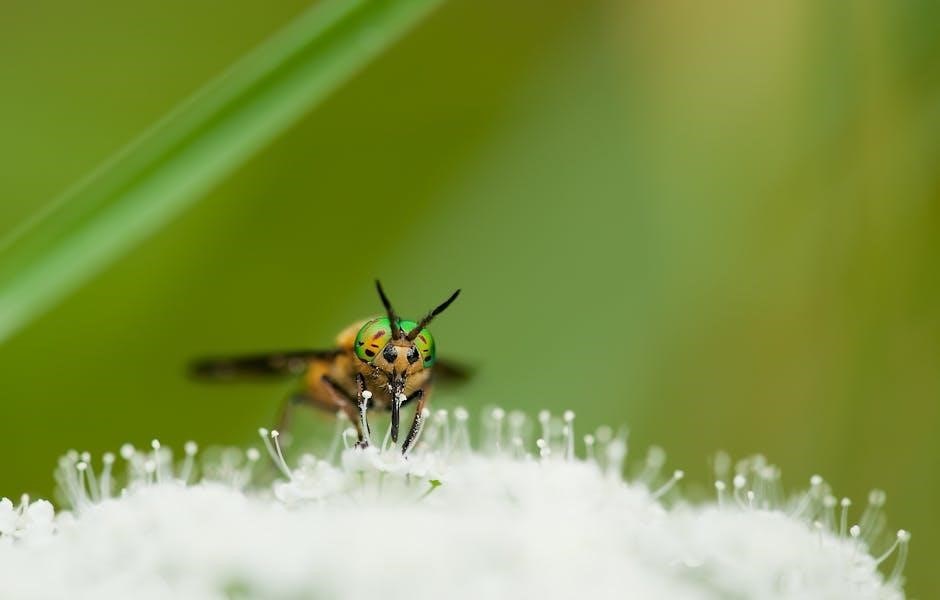William Golding’s Lord of the Flies is a gripping novel about young boys stranded on an island, exploring their descent into chaos and the nature of humanity․ It remains a timeless literary classic․
Overview of the Novel and Its Author
Lord of the Flies, written by William Golding, is a thought-provoking novel published in 1954․ It recounts the story of a group of young boys stranded on a remote island after a plane crash, exploring their attempts to self-govern and the gradual descent into chaos․ Golding, a British author and Nobel laureate, crafted this tale to examine human nature, societal norms, and the effects of isolation․ The novel has become a classic in modern literature, widely studied for its profound themes and psychological depth․
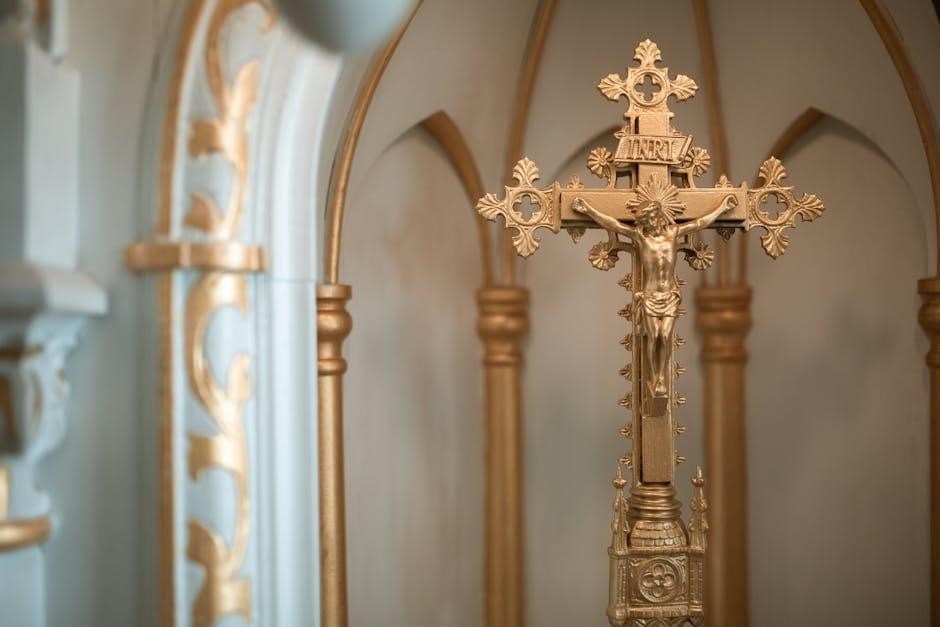
Plot of Lord of the Flies
Lord of the Flies follows a group of young boys stranded on a remote island after a plane crash․ Their initial attempts at cooperation and civility gradually unravel, revealing darker aspects of human nature as they descend into chaos and savagery․ The novel explores themes of survival, power, and morality through their experiences, culminating in a dramatic confrontation with reality and civilization․
Chapter 1: The Sound of the Shell
In the opening chapter, a group of young boys survives a plane crash and finds themselves stranded on a remote island․ The story introduces Ralph, Jack, and Piggy, who discover a conch shell that becomes a symbol of order and democracy․ Ralph is elected leader, and the boys attempt to create a civilized society․ The chapter sets the stage for their journey, exploring themes of leadership, cooperation, and the initial innocence of the characters before the island’s challenges begin to unfold․
Chapter 2: Fire on the Mountain
Chapter 2 focuses on the boys’ efforts to create a signal fire, symbolizing their hope for rescue․ Ralph, as leader, emphasizes the importance of the fire, while Jack’s enthusiasm for hunting begins to surface․ The chapter highlights the boys’ resourcefulness but also reveals the first signs of chaos․ The fire’s success brings temporary joy, yet its uncontrolled spread and the failure to signal a passing ship underscore the challenges of their primitive existence and the growing tensions within the group․
Chapter 3: Huts on the Beach
Chapter 3 explores the boys’ attempts to build shelters, reflecting their desire for safety and civilization․ Ralph’s leadership is tested as he balances practical needs with maintaining order․ The construction of huts symbolizes their effort to recreate society, but cracks begin to appear․ Jack’s growing obsession with hunting contrasts with Ralph’s focus on building, hinting at future conflicts․ The chapter highlights the boys’ resourcefulness but also reveals the fragile balance between cooperation and rivalry․
Analysis of the Plot Structure
The plot of Lord of the Flies unfolds chronologically, tracing the boys’ journey from hope to chaos․ The structure mirrors their moral descent, as order gives way to savagery․ Early chapters establish their civilized intentions, while later chapters reveal their primal instincts․ The conch shell, a symbol of democracy, gradually loses its power, reflecting the erosion of civility․ Golding’s use of episodic progression builds tension and underscores the themes of human nature, making the novel’s structure a powerful tool for exploring its central ideas․
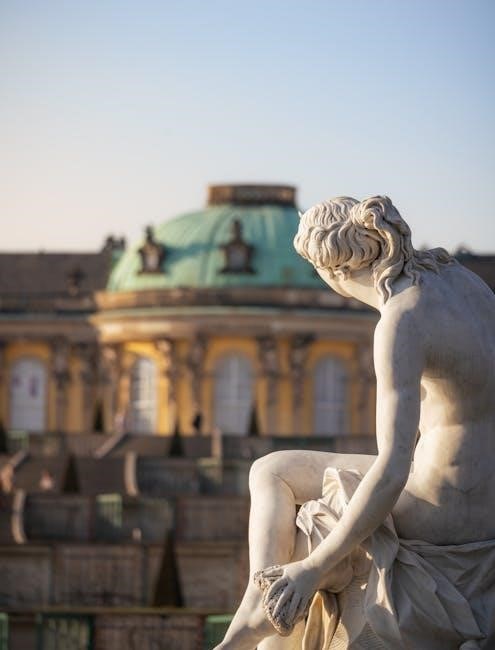
Themes in Lord of the Flies
The novel explores themes of human nature, savagery versus civilization, and the effects of isolation․ It delves into power dynamics, fear, and the moral decay of society․
The Nature of Humanity
Golding’s exploration of humanity reveals a duality between innate goodness and primal savagery․ Through the boys’ descent into chaos, the novel illustrates how societal constraints suppress inherent darker tendencies, which emerge when order collapses․ This concept challenges the notion of human innocence, suggesting that civilization is a fragile veneer masking deeper, more violent impulses․ The island setting strips away external controls, exposing the raw, often brutal nature of humanity․ This timeless theme resonates deeply, prompting reflections on human behavior and societal structures․
Savagery vs․ Civilization
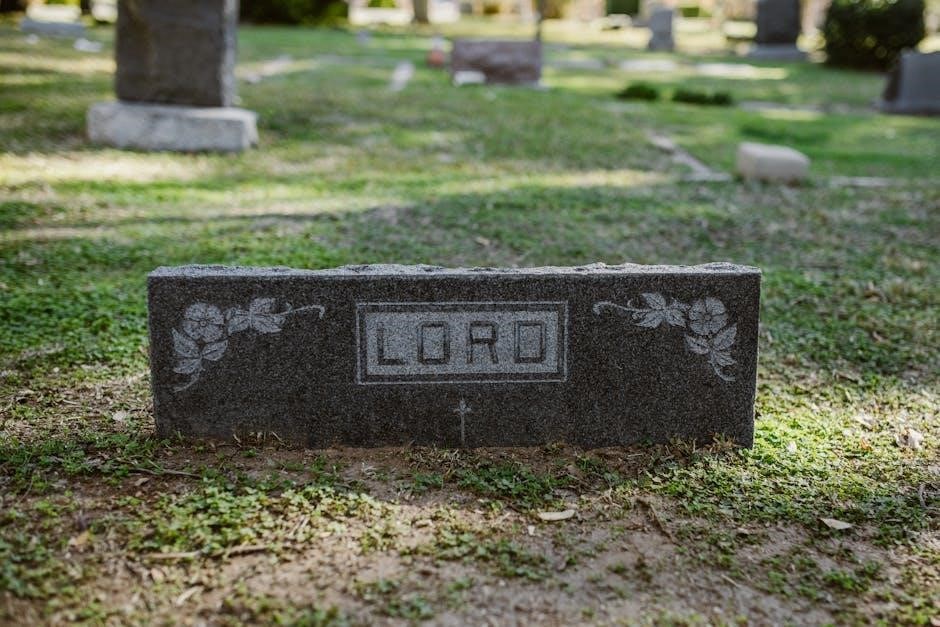
The novel explores the tension between savagery and civilization through the boys’ behavior on the island․ Initially, they attempt to create a civilized society, but primal instincts gradually prevail, leading to chaos․ The conch shell, a symbol of order, loses its power as fear and savagery dominate․ Jack’s obsession with hunting and power exemplifies the descent into savagery, while Ralph’s efforts to maintain civility highlight the struggle․ The island becomes a microcosm of human society, revealing how quickly civility can erode without external constraints, unleashing darker, primal behaviors․
Power Dynamics
In Lord of the Flies, power dynamics shape the boys’ interactions and decisions․ Initially, the conch shell symbolizes democratic power, but its influence wanes as fear and savagery rise․ Jack’s desire for control and dominance over others drives the group’s fragmentation, while Ralph’s leadership struggles to maintain civility․ The novel illustrates how power imbalances can lead to conflict, as individuals like Jack exploit fear to manipulate others․ Golding explores how inherent human tendencies toward dominance and submission emerge, even in isolation, reflecting broader societal hierarchies and struggles for authority․
The Role of Fear
Fear plays a pivotal role in Lord of the Flies, driving the boys’ actions and decisions․ The mysterious “beast” becomes a shared fear, which Jack exploits to gain power and control over the group․ As fear intensifies, it erodes the boys’ rationality and morals, leading to chaotic behavior․ Golding uses fear as a catalyst to explore how primal instincts and paranoia can dismantle societal norms, highlighting the fragility of human nature when faced with the unknown․

Morality and Ethics
Morality and ethics are central themes in Lord of the Flies, as the boys’ isolation forces them to confront their inner values․ Initially, they adhere to societal norms, but as time passes, their behavior becomes more primal․ The novel illustrates how morality is a product of civilization, and without external constraints, ethical standards deteriorate․ Golding suggests that true morality must be learned and upheld, highlighting the importance of societal structures in maintaining ethical behavior amidst the inherent darkness of human nature․
Leadership and Governance
Leadership and governance in Lord of the Flies are explored through the contrasting styles of Ralph and Jack․ Ralph represents democratic leadership, striving to maintain order and fairness, while Jack embodies authoritarianism, prioritizing power and control․ The novel highlights the challenges of establishing effective governance without societal structures, as the boys’ primitive instincts gradually overshadow their attempts at leadership․ Golding thus examines how leadership styles influence the balance between order and chaos in the absence of adult supervision․
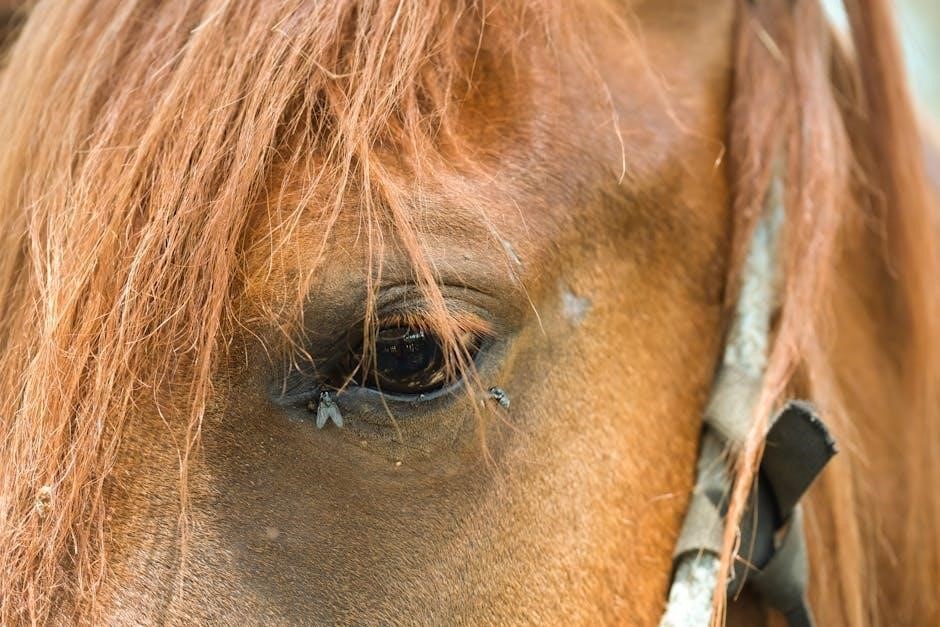
Characters in Lord of the Flies
Lord of the Flies features a diverse cast of characters, each representing distinct human traits․ Ralph symbolizes order, Jack embodies power, Piggy represents wisdom, and Simon signifies innocence, highlighting the novel’s exploration of human nature through their interactions and conflicts․
Ralph: The Protagonist
Ralph, the fair-haired leader, represents order and democracy․ Elected as the chief, he prioritizes building shelters and maintaining a signal fire․ His rationality and sense of responsibility often clash with Jack’s desire for power․ As the novel progresses, Ralph’s leadership is challenged, revealing his vulnerability and the gradual erosion of his civilized demeanor․ His character symbolizes the struggle between humanity’s innate goodness and the forces of savagery that emerge in the absence of societal constraints; Ralph’s journey mirrors the broader themes of the novel, highlighting the fragility of human morality․
Jack Merridew: The Antagonist
Jack Merridew, the choir leader, evolves from a disciplined boy to a power-hungry antagonist․ His obsession with hunting and desire for control lead him to challenge Ralph’s leadership․ Jack’s descent into savagery is marked by his fascination with violence and his eventual abandonment of civilization․ He symbolizes the primal instincts and the urge for dominance that emerge when societal norms are stripped away․ Jack’s transformation underscores the novel’s exploration of humanity’s darker tendencies and the blurred lines between order and chaos․
Piggy: The Voice of Reason
Piggy, the intelligent and rational character, represents logic and wisdom․ Despite his physical limitations, he provides insightful ideas and advocates for civilization․ His glasses symbolize clarity and knowledge, essential for the boys’ survival․ Piggy’s death marks the end of reason on the island, highlighting the triumph of savagery over intellect․ His character serves as a moral compass, emphasizing the importance of intelligence and cooperation in maintaining societal norms․ Piggy’s demise underscores the novel’s tragic commentary on humanity’s capacity for destruction․
Simon: The Truth-Seeker
Simon, a quiet and introspective boy, embodies innocence and spiritual awareness․ He discovers the truth about the “beast,” realizing it is a dead pilot, and seeks to share this revelation․ His connection to nature and deep understanding of humanity set him apart․ Simon’s tragic death at the hands of the other boys signifies the loss of innocence and the triumph of fear over reason․ His character symbolizes the pursuit of truth and the devastating consequences of unchecked savagery․ Simon’s wisdom and compassion highlight the novel’s exploration of humanity’s duality․
Roger: The Sadist
Roger, a tall and intimidating figure, exhibits a disturbing fascination with violence and control; Initially restrained by societal norms, he gradually embraces his sadistic tendencies, deriving pleasure from inflicting pain․ His actions, such as tormenting Henry and participating in Simon’s murder, highlight his moral decay․ Roger’s loyalty to Jack and his role in the tribe’s savagery underscore his willingness to abandon civility for power․ His character serves as a chilling example of humanity’s capacity for cruelty when unchecked by moral boundaries or authority․
Sam and Eric: The Loyal Followers
Sam and Eric, known as “Samneric,” are identical twins who remain steadfastly loyal to Ralph throughout the novel․ Their unity and shared perspective often provide a voice of reason, though they struggle to assert themselves independently․ Despite their loyalty, they are eventually coerced by Jack’s tribe, highlighting their vulnerability and the overwhelming pressure of group dynamics․ Their characters illustrate the tension between individual loyalty and the influence of power structures in a rapidly disintegrating society․
The Naval Officer: The Symbol of Authority
The naval officer represents civilized authority and order, arriving at the novel’s end to rescue the boys․ His presence starkly contrasts with the boys’ descent into savagery, emphasizing the fragility of their self-governed society․ The officer’s arrival underscores the theme of external authority restoring control, yet his obliviousness to the boys’ internal conflicts highlights the novel’s critique of societal structures and human nature․ His character serves as a symbolic bridge between the island’s chaos and the structured world beyond․
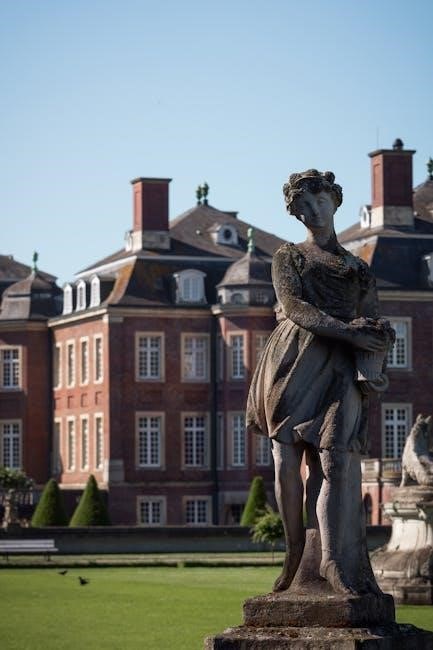
Symbols in Lord of the Flies
The novel is rich in symbolic elements, such as the conch shell, the beast, the island, fire, the pig’s head, and the naval officer, each representing themes like order, fear, and authority․
The Conch Shell
The conch shell is a powerful symbol of order and democracy in Lord of the Flies․ Found by Ralph, it is used to summon meetings and ensure only one person speaks at a time․ The shell’s presence maintains civility among the boys, representing unity and the rule of law․ As the novel progresses and chaos descends, the shell’s influence wanes, mirroring the boys’ descent into savagery․ It ultimately symbolizes the fragile nature of order and the ease with which it can be lost․
The Beast
The Beast is a mysterious entity the boys believe inhabits the island, striking fear into their hearts․ Initially, it is dismissed as a childish superstition, but as time passes, the boys’ paranoia grows, and the Beast becomes a shared delusion․ This fear is exploited by Jack to gain power, symbolizing how irrational fears can control human behavior․ The Beast represents the unknown and the primal terrors that exist within humanity, driving the boys further from civilization and deeper into savagery․
The Island
The island serves as both a setting and a symbol in Lord of the Flies․ Once a paradise, it transforms into a place of savagery as the boys’ civilized instincts erode․ The island’s beauty contrasts with the ugliness of human nature, highlighting the tension between order and chaos․ It represents isolation and the effects of being removed from societal constraints, allowing Golding to explore themes of humanity’s inherent flaws and the decline of morality in the absence of authority․
Fire
Fire is a pivotal symbol in Lord of the Flies, representing both civilization and destruction․ Initially, it serves as a beacon of hope, a tool for signaling rescue and maintaining order․ However, as the boys’ savagery grows, fire becomes a force of chaos, symbolizing their descent into primal behavior․ The loss of control over fire mirrors their loss of moral grounding, highlighting the fragility of civilization and the inevitability of chaos when humanity’s darker instincts prevail․ Fire thus embodies the duality of human nature․
The Lord of the Flies (The Pig’s Head)
The pig’s head, impaled on a stake and left to rot, symbolizes the true nature of humanity and the evil that resides within․ It represents the “beast” the boys fear, embodying their deepest anxieties and primal instincts․ The pig’s head, referred to as the “Lord of the Flies,” serves as a grim reminder of the boys’ descent into savagery․ It also alludes to the biblical concept of Beelzebub, signifying corruption and chaos․ The pig’s head becomes a twisted idol, reflecting the island’s moral decay and the triumph of savagery over civility․
The Naval Officer
The naval officer represents the return of authority and civilization, arriving to rescue the boys․ His presence contrasts sharply with the island’s descent into chaos, highlighting the boys’ regression into savagery․ The officer’s dismissive attitude toward their primal behavior underscores the novel’s themes of civilization versus savagery․ His arrival symbolizes the restored order of society, yet also serves as a reminder of the fragility of human morality․ The officer’s character reinforces Golding’s exploration of humanity’s duality and the thin line between civility and primal instincts․

Significance of the Title
The title Lord of the Flies refers to the biblical “Beelzebub,” symbolizing evil and chaos․ It reflects the novel’s exploration of humanity’s darker instincts and societal collapse․
Meaning and Relevance of “Lord of the Flies”
The title Lord of the Flies originates from the biblical term “Beelzebub,” symbolizing evil and chaos․ It reflects the novel’s exploration of humanity’s darker instincts, as the boys’ civilized behavior crumbles․ The pig’s head, representing the “Lord of the Flies,” embodies the primal savagery and fear that dominate the island․ This title underscores the universal theme of inherent evil, making the novel a timeless commentary on human nature and societal collapse․ Its relevance endures as a cautionary tale about unchecked human behavior․

Cultural and Literary Impact
Lord of the Flies has profoundly influenced literature, sparking debates on human nature and societal structures․ Its themes resonate across generations, inspiring films, educational curriculums, and modern adaptations․
Film Adaptations
The novel has been adapted into films, with the 1963 version by Peter Brook and the 1990 adaptation by Harry Hook being the most notable; These films capture the essence of Golding’s narrative, exploring themes of savagery and civilization․ The 1963 film, shot in black-and-white, stayed faithful to the book’s tone, while the 1990 version introduced color and a modern twist․ Both adaptations highlight the timeless relevance of the story, making it accessible to new audiences and cementing its cultural impact․ The films remain a testament to the novel’s enduring legacy․
Literary Significance
Lord of the Flies is a modern classic, celebrated for its profound exploration of human nature, morality, and society․ William Golding’s allegorical novel has become a cornerstone of educational curricula worldwide, sparking debates on civilization versus savagery․ Its vivid portrayal of boys descending into chaos resonates universally, offering insights into power dynamics, fear, and ethics․ The novel’s themes are timeless, making it a pivotal work in 20th-century literature and a must-read for understanding human behavior in isolation․ Its influence extends beyond literature, shaping cultural and philosophical discussions․
Use in Educational Curriculum
Lord of the Flies is widely taught in schools due to its universal themes and thought-provoking narrative․ Educators use the novel to explore human nature, morality, and societal structures․ Its allegorical style encourages critical thinking and analytical skills, making it a valuable tool for understanding complex ideas․ The novel’s relevance to adolescent development and its ability to spark discussions on ethics, leadership, and civilization versus savagery ensure its continued presence in educational curricula worldwide․
Modern Relevance
Lord of the Flies remains strikingly relevant today, offering insights into human behavior, societal collapse, and the effects of unchecked power․ Its exploration of primal instincts, group dynamics, and the breakdown of morality resonates in contemporary discussions on politics, social media, and leadership․ The novel’s themes of fear, authority, and the duality of human nature continue to mirror real-world challenges, making it a timeless commentary on civilization and its fragility in modern society․
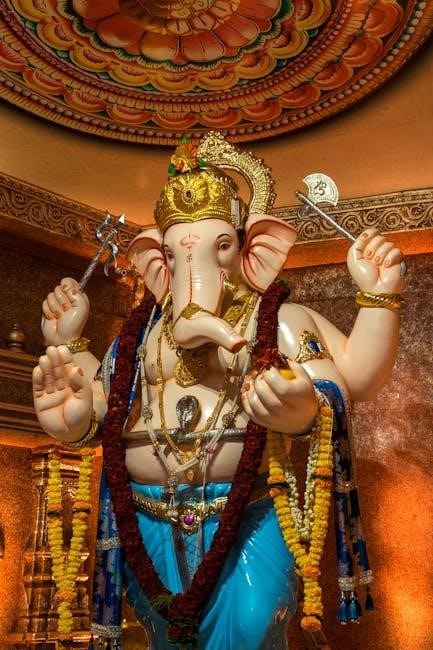
Resources for Readers
Download Lord of the Flies in PDF, ePub, or TXT formats for free from various online platforms․ Study guides, summaries, and discussions are also available for deeper understanding․
How to Download the PDF
To download Lord of the Flies in PDF format, visit trusted platforms like Open Library or Google Drive․ Search for “Lord of the Flies PDF” and select a reliable source․ Some sites may require account creation for access․ Once found, click the download link to save the file․ Ensure the source is reputable to avoid malware․ The novel is also available in ePub and TXT formats for convenient reading․ This allows readers to access William Golding’s classic tale for personal use or study purposes easily․
Study Guides and Summaries
Study guides and summaries for Lord of the Flies are widely available online, offering detailed analysis and insights into the novel’s themes, characters, and plot․ Websites like Open Library, SparkNotes, and CliffsNotes provide comprehensive breakdowns of each chapter, key quotes, and essay topics․ These resources are invaluable for students studying the novel, helping them understand complex concepts like savagery vs․ civilization and the nature of humanity․ They also include discussion questions and analysis of symbolism, making them essential tools for academic preparation and deeper comprehension of the text․
Online Discussions and Forums
Online discussions and forums about Lord of the Flies are vibrant spaces where readers share insights, interpretations, and analyses of the novel․ Platforms like Reddit, Goodreads, and literary forums host debates on themes such as savagery vs․ civilization, leadership, and morality․ Fans and scholars alike engage in meaningful conversations, exploring the deeper meanings of Golding’s work․ These forums also provide opportunities for readers to connect globally, fostering a community of learners and enthusiasts passionate about the novel’s timeless relevance and universal themes․
